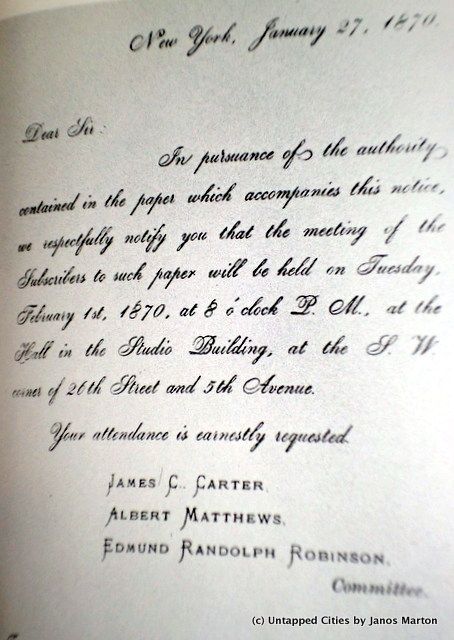Last-Minute NYC Holiday Gift Guide 🎁
We’ve created a holiday gift guide with presents for the intrepid New Yorker that should arrive just in time—


Introducing a column by Janos Marton of janos.nyc, writer, urban enthusiast, and political expert, a former counsel to the New York State Moreland Commission who made a splash this past fall blasting Governor Cuomo for his interference in the anti-corruption panel. Reviving the Untapped Cities column, “Today in NYC History, Marton will be exploring, daily, historical events in New York City history that have resonance today.

Invitation lawyers received to the founding session of the City Bar.
“Bench and bar settle deeper in the mud every year and every month. They must be near the bottom now.” – George Templeton, 1868.
Late 1860s New York City was in the firm clutches of the Tammany Hall political machine, run at the time by the notorious Boss Tweed. Tweed operatives were prominently placed throughout the government and judiciary, and corruption in the legal system had become a source of derision and despair among lawyers and regular New Yorkers alike. On February 1, 1870, the Bar of the City of New York (“City Bar”) was founded to bring integrity back to the legal system.
Morale in the legal industry was already low by the late 1860s, but the final straw was a legal battle between robber barons Cornelius Vanderbilt and Jay Gould for control of the lucrative Erie Railroad, a scandal featuring bribed judges and bribed legislators. The case was widely mocked in the press, and The New York Times demanded that the legal profession do something to restore order in the court system.
A group of the City’s elite lawyers were already working behind the scenes. In December 1869, they published a letter calling for a local bar association to “sustain the the profession in its proper position, and thereby enable it, in many ways, to promote the interest of the public…” Over 200 lawyers quickly signed on.
The main organizer was William Evarts, who had earned considerable fame winning the 1853 Lemmon slave case, in which the state court upheld the freedom of blacks in New York, and his representation of President Andrew Johnson during his impeachment trial. Evarts presided over the first City Bar meeting, on February 1, 1870, and served as president until 1879.
Henry Nicolls spoke longest at that meeting. He attributed the legal industry’s decay to the public perception that top lawyers always defended rich landlords over tenants and New York’s 1846 Constitution, which dramatically lowered the requirements for becoming a lawyer. These low barriers allowed Tammany to pack legal positions with cronies. Nicolls thus established two Bar Association hallmarks: setting standards for entry into the legal field and making at least rhetorical commitments to public service.
The most riveting speech that evening was given by Samuel Tilden, who argued that legal reform was more than a moral issue: “[T]he City of New York is the commercial and monetary capital of this continent. If it would remain so, it must establish an elevated character for its Bar, and a reputation through the whole country for its purity in the administration of justice…it is impossible for New York to remain the centre of commerce and capital for this continent, unless it has an independent Bar and an honest judiciary.” The next year Tilden chaired the Committee of 70, an investigation into the Tweed Ring that led to Boss Tweed’s demise. Tilden later served as governor, and in 1876 lost the presidential election despite winning the most popular votes.
Today the City Bar has over 24,000 members. New York attorneys and law students are not required to join, but do so to participate in professional committees, network, and attend programming. The City Bar has over 150 committees; I had the pleasure of serving on the Civil Rights Committee, which advises on local legislation, files amicus briefs and reports on issues to the Bar. It’s a great organization, and New York City should be thrilled that it has long outlasted Tammany Hall.
Much of this history is taken from the New York City Bar Association’s history, Causes and Conflicts. For more information on NYC political history, visit Janos.nyc.
Subscribe to our newsletter